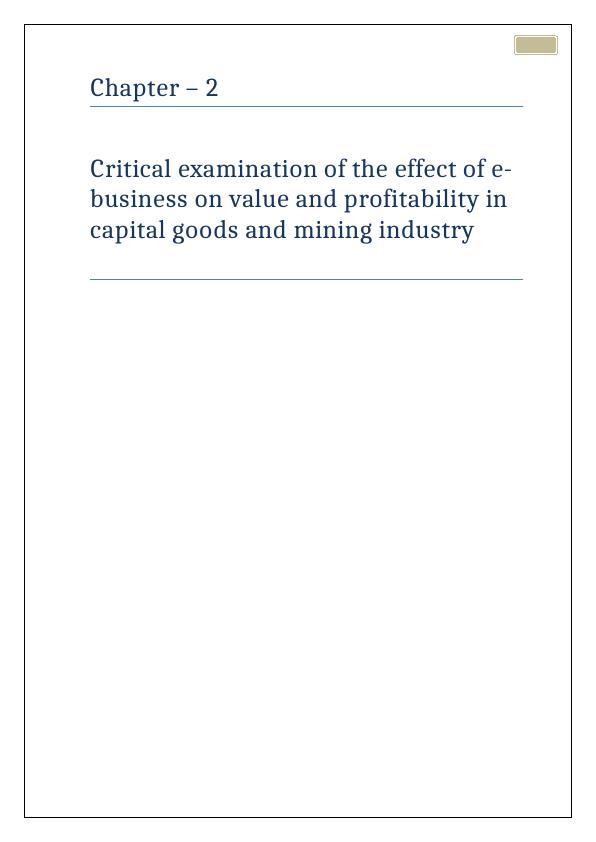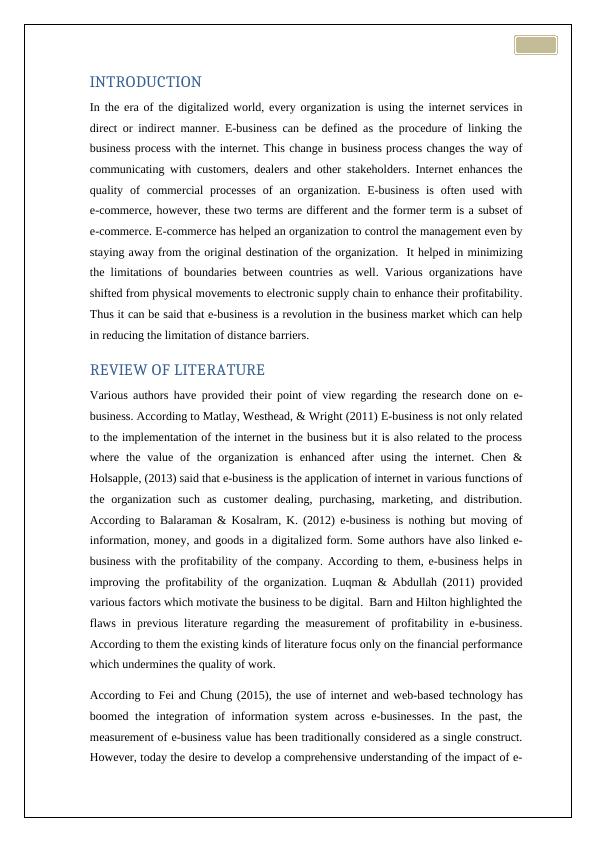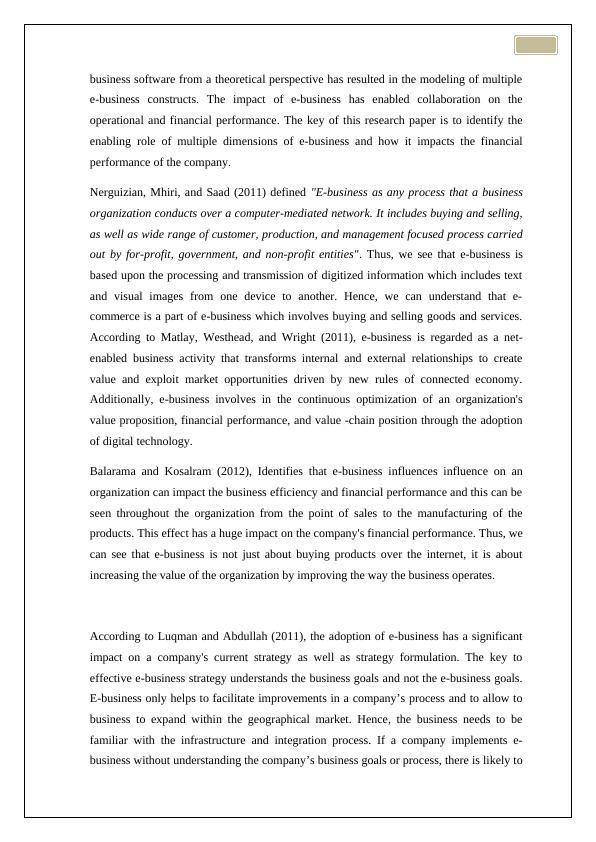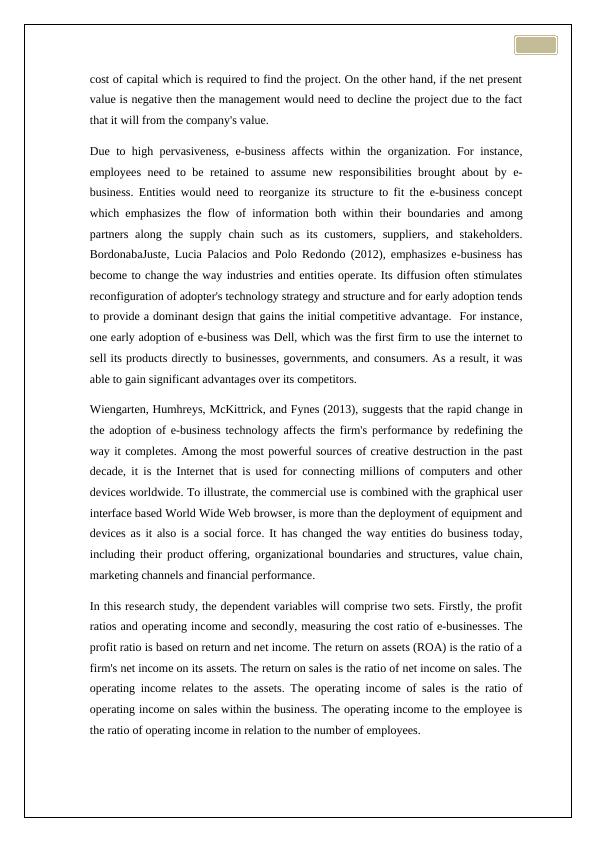Critical Examination of the Effect of E-business on Value and Profitability in Capital Goods and Mining Industry
Added on 2023-06-10
28 Pages9798 Words492 Views
Chapter – 2
Critical examination of the effect of e-
business on value and profitability in
capital goods and mining industry
Critical examination of the effect of e-
business on value and profitability in
capital goods and mining industry

Table of Contents
INTRODUCTION.....................................................................................................................................2
REVIEW OF LITERATURE........................................................................................................................3
CONCEPTUAL FRAMEWORK................................................................................................................20
BIBLIOGRAPHY.....................................................................................................................................21
INTRODUCTION.....................................................................................................................................2
REVIEW OF LITERATURE........................................................................................................................3
CONCEPTUAL FRAMEWORK................................................................................................................20
BIBLIOGRAPHY.....................................................................................................................................21

INTRODUCTION
In the era of the digitalized world, every organization is using the internet services in
direct or indirect manner. E-business can be defined as the procedure of linking the
business process with the internet. This change in business process changes the way of
communicating with customers, dealers and other stakeholders. Internet enhances the
quality of commercial processes of an organization. E-business is often used with
e-commerce, however, these two terms are different and the former term is a subset of
e-commerce. E-commerce has helped an organization to control the management even by
staying away from the original destination of the organization. It helped in minimizing
the limitations of boundaries between countries as well. Various organizations have
shifted from physical movements to electronic supply chain to enhance their profitability.
Thus it can be said that e-business is a revolution in the business market which can help
in reducing the limitation of distance barriers.
REVIEW OF LITERATURE
Various authors have provided their point of view regarding the research done on e-
business. According to Matlay, Westhead, & Wright (2011) E-business is not only related
to the implementation of the internet in the business but it is also related to the process
where the value of the organization is enhanced after using the internet. Chen &
Holsapple, (2013) said that e-business is the application of internet in various functions of
the organization such as customer dealing, purchasing, marketing, and distribution.
According to Balaraman & Kosalram, K. (2012) e-business is nothing but moving of
information, money, and goods in a digitalized form. Some authors have also linked e-
business with the profitability of the company. According to them, e-business helps in
improving the profitability of the organization. Luqman & Abdullah (2011) provided
various factors which motivate the business to be digital. Barn and Hilton highlighted the
flaws in previous literature regarding the measurement of profitability in e-business.
According to them the existing kinds of literature focus only on the financial performance
which undermines the quality of work.
According to Fei and Chung (2015), the use of internet and web-based technology has
boomed the integration of information system across e-businesses. In the past, the
measurement of e-business value has been traditionally considered as a single construct.
However, today the desire to develop a comprehensive understanding of the impact of e-
In the era of the digitalized world, every organization is using the internet services in
direct or indirect manner. E-business can be defined as the procedure of linking the
business process with the internet. This change in business process changes the way of
communicating with customers, dealers and other stakeholders. Internet enhances the
quality of commercial processes of an organization. E-business is often used with
e-commerce, however, these two terms are different and the former term is a subset of
e-commerce. E-commerce has helped an organization to control the management even by
staying away from the original destination of the organization. It helped in minimizing
the limitations of boundaries between countries as well. Various organizations have
shifted from physical movements to electronic supply chain to enhance their profitability.
Thus it can be said that e-business is a revolution in the business market which can help
in reducing the limitation of distance barriers.
REVIEW OF LITERATURE
Various authors have provided their point of view regarding the research done on e-
business. According to Matlay, Westhead, & Wright (2011) E-business is not only related
to the implementation of the internet in the business but it is also related to the process
where the value of the organization is enhanced after using the internet. Chen &
Holsapple, (2013) said that e-business is the application of internet in various functions of
the organization such as customer dealing, purchasing, marketing, and distribution.
According to Balaraman & Kosalram, K. (2012) e-business is nothing but moving of
information, money, and goods in a digitalized form. Some authors have also linked e-
business with the profitability of the company. According to them, e-business helps in
improving the profitability of the organization. Luqman & Abdullah (2011) provided
various factors which motivate the business to be digital. Barn and Hilton highlighted the
flaws in previous literature regarding the measurement of profitability in e-business.
According to them the existing kinds of literature focus only on the financial performance
which undermines the quality of work.
According to Fei and Chung (2015), the use of internet and web-based technology has
boomed the integration of information system across e-businesses. In the past, the
measurement of e-business value has been traditionally considered as a single construct.
However, today the desire to develop a comprehensive understanding of the impact of e-

business software from a theoretical perspective has resulted in the modeling of multiple
e-business constructs. The impact of e-business has enabled collaboration on the
operational and financial performance. The key of this research paper is to identify the
enabling role of multiple dimensions of e-business and how it impacts the financial
performance of the company.
Nerguizian, Mhiri, and Saad (2011) defined "E-business as any process that a business
organization conducts over a computer-mediated network. It includes buying and selling,
as well as wide range of customer, production, and management focused process carried
out by for-profit, government, and non-profit entities". Thus, we see that e-business is
based upon the processing and transmission of digitized information which includes text
and visual images from one device to another. Hence, we can understand that e-
commerce is a part of e-business which involves buying and selling goods and services.
According to Matlay, Westhead, and Wright (2011), e-business is regarded as a net-
enabled business activity that transforms internal and external relationships to create
value and exploit market opportunities driven by new rules of connected economy.
Additionally, e-business involves in the continuous optimization of an organization's
value proposition, financial performance, and value -chain position through the adoption
of digital technology.
Balarama and Kosalram (2012), Identifies that e-business influences influence on an
organization can impact the business efficiency and financial performance and this can be
seen throughout the organization from the point of sales to the manufacturing of the
products. This effect has a huge impact on the company's financial performance. Thus, we
can see that e-business is not just about buying products over the internet, it is about
increasing the value of the organization by improving the way the business operates.
According to Luqman and Abdullah (2011), the adoption of e-business has a significant
impact on a company's current strategy as well as strategy formulation. The key to
effective e-business strategy understands the business goals and not the e-business goals.
E-business only helps to facilitate improvements in a company’s process and to allow to
business to expand within the geographical market. Hence, the business needs to be
familiar with the infrastructure and integration process. If a company implements e-
business without understanding the company’s business goals or process, there is likely to
e-business constructs. The impact of e-business has enabled collaboration on the
operational and financial performance. The key of this research paper is to identify the
enabling role of multiple dimensions of e-business and how it impacts the financial
performance of the company.
Nerguizian, Mhiri, and Saad (2011) defined "E-business as any process that a business
organization conducts over a computer-mediated network. It includes buying and selling,
as well as wide range of customer, production, and management focused process carried
out by for-profit, government, and non-profit entities". Thus, we see that e-business is
based upon the processing and transmission of digitized information which includes text
and visual images from one device to another. Hence, we can understand that e-
commerce is a part of e-business which involves buying and selling goods and services.
According to Matlay, Westhead, and Wright (2011), e-business is regarded as a net-
enabled business activity that transforms internal and external relationships to create
value and exploit market opportunities driven by new rules of connected economy.
Additionally, e-business involves in the continuous optimization of an organization's
value proposition, financial performance, and value -chain position through the adoption
of digital technology.
Balarama and Kosalram (2012), Identifies that e-business influences influence on an
organization can impact the business efficiency and financial performance and this can be
seen throughout the organization from the point of sales to the manufacturing of the
products. This effect has a huge impact on the company's financial performance. Thus, we
can see that e-business is not just about buying products over the internet, it is about
increasing the value of the organization by improving the way the business operates.
According to Luqman and Abdullah (2011), the adoption of e-business has a significant
impact on a company's current strategy as well as strategy formulation. The key to
effective e-business strategy understands the business goals and not the e-business goals.
E-business only helps to facilitate improvements in a company’s process and to allow to
business to expand within the geographical market. Hence, the business needs to be
familiar with the infrastructure and integration process. If a company implements e-
business without understanding the company’s business goals or process, there is likely to

be an e-business failure. Like all traditional businesses, e-business needs to be evaluated
regularly as the business strategy is not a onetime event.
The purpose of this research paper is to critically examine the role of e-business
innovation on a firm's performance. It follows the footstep of past researchers who
described organizational innovation as a more important to understand how innovation
theory can explain one particular innovation instead of searching a single unifying theory
that explains all innovations in general Caldwell, Harland, Powell, and Zeng (2013).
However, the current research applies to organizational innovation theory in relation to e-
business. This research will discuss e-business innovation and how this affects the
business success by combining early adoption and innovative use of e-business to an
entities performance.
The well-recognized work of Fei and Cheng (2015), highlights the significance of
innovation as the source of value creation. He also suggests that innovation can not only
change the way businesses operate, but has even been called "creative destruction" due to
its radical nature. Matlay, Westhead, and Wright (2011) believed innovation theory
focuses on the importance of technology and identifies that innovation recognizes the use
of technology as the foundation of new products and production methods. For instance,
the implementation of new goods or a new method of production, the introduction of a
new market and, or the development of a new source of supply of raw materials or partly
manufactured goods.
According to Saleem and Dhavachelvan (2011), the high uncertainty characteristics of e-
business challenges high-level management involved in e-business. It is the innovative
use of technology that differentiates superior performance from the inferior ones. Such
innovative use often accompanies the introduction of new goods or even a new method of
production.
According to Ruoco and Durfee (2001), it is established that larger organizations find it
difficult to adapt to the traditional capital budgeting method, which commencing e-
business projects. E-business focuses on senior management to adopt a non-traditional
approach while measuring the payoff of a project. Hence, senior management tends to
discount the time value of money and calculate it with the Net Present Value (NPV) of
the project. Thus, management can decide that, if the net present value is positive then
they should fund the project since it will generate value for the company in excess of the
regularly as the business strategy is not a onetime event.
The purpose of this research paper is to critically examine the role of e-business
innovation on a firm's performance. It follows the footstep of past researchers who
described organizational innovation as a more important to understand how innovation
theory can explain one particular innovation instead of searching a single unifying theory
that explains all innovations in general Caldwell, Harland, Powell, and Zeng (2013).
However, the current research applies to organizational innovation theory in relation to e-
business. This research will discuss e-business innovation and how this affects the
business success by combining early adoption and innovative use of e-business to an
entities performance.
The well-recognized work of Fei and Cheng (2015), highlights the significance of
innovation as the source of value creation. He also suggests that innovation can not only
change the way businesses operate, but has even been called "creative destruction" due to
its radical nature. Matlay, Westhead, and Wright (2011) believed innovation theory
focuses on the importance of technology and identifies that innovation recognizes the use
of technology as the foundation of new products and production methods. For instance,
the implementation of new goods or a new method of production, the introduction of a
new market and, or the development of a new source of supply of raw materials or partly
manufactured goods.
According to Saleem and Dhavachelvan (2011), the high uncertainty characteristics of e-
business challenges high-level management involved in e-business. It is the innovative
use of technology that differentiates superior performance from the inferior ones. Such
innovative use often accompanies the introduction of new goods or even a new method of
production.
According to Ruoco and Durfee (2001), it is established that larger organizations find it
difficult to adapt to the traditional capital budgeting method, which commencing e-
business projects. E-business focuses on senior management to adopt a non-traditional
approach while measuring the payoff of a project. Hence, senior management tends to
discount the time value of money and calculate it with the Net Present Value (NPV) of
the project. Thus, management can decide that, if the net present value is positive then
they should fund the project since it will generate value for the company in excess of the

cost of capital which is required to find the project. On the other hand, if the net present
value is negative then the management would need to decline the project due to the fact
that it will from the company's value.
Due to high pervasiveness, e-business affects within the organization. For instance,
employees need to be retained to assume new responsibilities brought about by e-
business. Entities would need to reorganize its structure to fit the e-business concept
which emphasizes the flow of information both within their boundaries and among
partners along the supply chain such as its customers, suppliers, and stakeholders.
BordonabaJuste, Lucia Palacios and Polo Redondo (2012), emphasizes e-business has
become to change the way industries and entities operate. Its diffusion often stimulates
reconfiguration of adopter's technology strategy and structure and for early adoption tends
to provide a dominant design that gains the initial competitive advantage. For instance,
one early adoption of e-business was Dell, which was the first firm to use the internet to
sell its products directly to businesses, governments, and consumers. As a result, it was
able to gain significant advantages over its competitors.
Wiengarten, Humhreys, McKittrick, and Fynes (2013), suggests that the rapid change in
the adoption of e-business technology affects the firm's performance by redefining the
way it completes. Among the most powerful sources of creative destruction in the past
decade, it is the Internet that is used for connecting millions of computers and other
devices worldwide. To illustrate, the commercial use is combined with the graphical user
interface based World Wide Web browser, is more than the deployment of equipment and
devices as it also is a social force. It has changed the way entities do business today,
including their product offering, organizational boundaries and structures, value chain,
marketing channels and financial performance.
In this research study, the dependent variables will comprise two sets. Firstly, the profit
ratios and operating income and secondly, measuring the cost ratio of e-businesses. The
profit ratio is based on return and net income. The return on assets (ROA) is the ratio of a
firm's net income on its assets. The return on sales is the ratio of net income on sales. The
operating income relates to the assets. The operating income of sales is the ratio of
operating income on sales within the business. The operating income to the employee is
the ratio of operating income in relation to the number of employees.
value is negative then the management would need to decline the project due to the fact
that it will from the company's value.
Due to high pervasiveness, e-business affects within the organization. For instance,
employees need to be retained to assume new responsibilities brought about by e-
business. Entities would need to reorganize its structure to fit the e-business concept
which emphasizes the flow of information both within their boundaries and among
partners along the supply chain such as its customers, suppliers, and stakeholders.
BordonabaJuste, Lucia Palacios and Polo Redondo (2012), emphasizes e-business has
become to change the way industries and entities operate. Its diffusion often stimulates
reconfiguration of adopter's technology strategy and structure and for early adoption tends
to provide a dominant design that gains the initial competitive advantage. For instance,
one early adoption of e-business was Dell, which was the first firm to use the internet to
sell its products directly to businesses, governments, and consumers. As a result, it was
able to gain significant advantages over its competitors.
Wiengarten, Humhreys, McKittrick, and Fynes (2013), suggests that the rapid change in
the adoption of e-business technology affects the firm's performance by redefining the
way it completes. Among the most powerful sources of creative destruction in the past
decade, it is the Internet that is used for connecting millions of computers and other
devices worldwide. To illustrate, the commercial use is combined with the graphical user
interface based World Wide Web browser, is more than the deployment of equipment and
devices as it also is a social force. It has changed the way entities do business today,
including their product offering, organizational boundaries and structures, value chain,
marketing channels and financial performance.
In this research study, the dependent variables will comprise two sets. Firstly, the profit
ratios and operating income and secondly, measuring the cost ratio of e-businesses. The
profit ratio is based on return and net income. The return on assets (ROA) is the ratio of a
firm's net income on its assets. The return on sales is the ratio of net income on sales. The
operating income relates to the assets. The operating income of sales is the ratio of
operating income on sales within the business. The operating income to the employee is
the ratio of operating income in relation to the number of employees.

End of preview
Want to access all the pages? Upload your documents or become a member.
Related Documents
Assignment | THE INTERNET AND E-BUSINESS.lg...
|13
|2452
|16
Critical Examination of the Effect of E-Business on Value and Profitability of Firm in Mining & Engineering Product Manufacture Industrylg...
|8
|2241
|460
Assignment on Security and Issues in E-commercelg...
|12
|3066
|46
E-Business Methodologies Reportlg...
|3
|568
|15
Report on Business Skills for e-Commerce : John Lewislg...
|8
|1788
|98
Motivation Factors and Business Model Canvas for a New E-Business Idealg...
|9
|1856
|80
